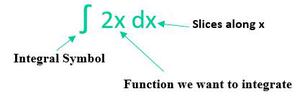分部整合
积分是积分的计算,在数学中用于查找许多有用的量,例如面积、体积、位移等,这些量是由于无法单独测量的小数据的集合而发生的。积分用“∫”表示。

积分符号
集成的概念用于解决以下两种类型的问题:
- 给定导数后,求问题函数,
- 在某些特定约束下找到由函数图包围的区域。
这两个问题导致了称为“积分”的概念的发展,该概念由以下两种积分组成:
- 定积分:包括上限和下限的积分称为定积分。定积分也称为黎曼积分。一个明确的积分表示为:
- 不定积分:不定积分没有上限和下限。它表示为:
∫f(x)dx = F(x) + C
这里 C 是一个常数,f(x) 是一个函数 这被称为被积函数。
有五种类型的集成方法可用:
- 替代整合
- 按部分规则集成
- 部分分数积分
- 使用三角恒等式积分
- 某些特定函数的集成
在这里,我们只讨论部分集成。
分部整合
分部集成是一种集成方法,常用于集成两个功能的产品。该技术用于通过将积分简化为标准形式来查找积分。以下公式用于按部分执行积分:
在哪里:
u 是 x 的第一个函数:u(x)
v 是 x 的第二个函数:v(x)
分部积分公式:
在哪里:
a 是下限
b 是上限
按零件公式推导积分:
Suppose u and w are any two differentiable functions of a single variable y.
As we already know how to differentiate a product,
y = uw
then, by the product rule of differentiation
dy/dx = d⁄dx(uw) = u d/dx(w) + w d/dx(u)
Rearranging this, we get
u d/dx(w) = d⁄dx(uw) – w d/dx(u)
or
uw’ = d⁄dx(wu) – wu’
On integrating both sides w.r.t x, we get
∫(uw’)dx = ∫d/dx(uw) dx – ∫(wu’)dx
The first term on the right simplifies, since
we are simply integrating what has been differentiated.
Therefore,
∫(uw’)dx = uw – ∫(u’w) dx
Now put
w’ = v
w = ∫v
Substituting the above values, we get
∫(uv)dx = u(∫vdx) – ∫(u’∫vdx)dx
部分积分规则:
- 选择第一个函数为u ,第二个函数为dv/dx 。
- 区分你:你'
- 积分 dv/dx: (∫(dv/dx)dx = v)
- 将 u, u', v 和 ∫(dv/dx)dx 代入: u(∫vdx) −∫(u' ∫vdx) dx
- 简化和解决
ILATE 规则
在按部分积分中,通常,我们使用优先顺序来决定第一个函数,使用ILATE规则(反三角函数、对数函数、代数函数、三角函数、指数函数)。该规则规定,在执行积分时,应将函数假定为第一个函数。因此,根据所涉及的函数类型,通过将(ILATE 的)左项视为第一个函数,将(ILATE 的)第二项视为第二个函数,假设函数按从左到右的顺序排列。所以, ILATE 是我们选择第一个函数的顺序。

以下是函数u 的以下步骤,其中
I = Inverse trigonometric functions
such as sin-1 (x), cos-1 (x), tan-1 (x)
L = Logarithmic functions
such as ln(x), log(x)
A = Algebraic functions
such as x2, x3
T = Trigonometric functions
such as sin(x), cos(x), tan(x)
E = Exponential functions
such as ex, 3x
示例问题
问题 1. 计算 ∫2x cos(x)dx
解决方案:
Given that, ∫2x cos(x)dx
According to the rule of integration by parts,
Let us consider,
u = 2x and dv/dx = cos(x)
Then
du/dx = 2 and v = ∫cos(x) = sin(x)
Now, using the formula for integration by parts;
∫u(dv/dx)dx = uv – ∫v(du/dx)dx
We get,
∫2x cox(x)dx = 2x sin(x) – ∫sinx.2dx
∫2x cos(x)dx = 2x sin(x) + 2cos(x) + c
where c is a constant.
问题 2. 计算∫3x ln|x| dx
解决方案:
Given, ∫3xln|x| dx
According to rule of integration by parts,
Let us consider,
u = ln|x| and dv/dx = 3x
Then
du/dx = 1/x and v = ∫3xdx = 3x2/2
Now, using the formula for integration by parts,
∫u(dv/dx)dx = uv – ∫v(du/dx)dx
∫3x ln|x|dx = ln|x|.3x2/2 – ∫3x2/2(1/x)dx
= 3x2/2(ln|x|) – ∫3x/2 dx
= 3x2/2(ln|x|) – 3x2/4 + C
where C is a constant.
问题 3. 评估∫10x 2
解决方案:
Given that, ∫10x2
According to rule of integration by parts,
Let us consider,
u = 10x2 and dv/dx = 1
Then
du/dx = 20x and v = ∫(1)dx = x
Now, using the formula for integration by parts;
∫u(dv/dx)dx = uv – ∫v(du/dx)dx
∫10x2 dx = 10x2x – ∫x(20x)dx
∫10x2 dx = 10x3 – ∫20x2dx
∫10x2 dx = 10x3 – 20/3x3 + C
∫10x2 dx = 10x3/3 + C
where C is a constant.
问题 4. 计算 ∫x 2 e 4x dx
解决方案:
Given that, ∫x2 e4x dx
According to rule of integration by parts,
Let us consider,
u = x2 and dv/dx = e4x
Then
du/dx = 2x and v = ∫e4x dx = 1/4(e4x)
Then, using the formula for integration by parts,
∫u(dv/dx)dx = uv – ∫v(du/dx)dx
∫x2e4x dx = (x2)1/4(e4x) – ∫1/4(e4x)(2x)dx
= 1/4(x2)(e4x) – ∫2/4(x)(e4x)dx
= 1/4(x2)(e4x) – ∫1/2(x)(e4x)dx
The resulting integral is still a product of
two functions i.e. 1/2(x) and e4x.
So, We use the formula for integration again.
This time we take
u = 1/2(x) and dv/dx = e4x
So
du/dx = 1/2 and v = ∫e4xdx = 1/4(e4x)
Now, on putting these values in above equation,
∫x2e4x dx = 1/4(x2)(e4x) – ∫2/4(x)(e4x)dx
= 1/4(x2e4x) – {2/4(x).1/4(e4x) – ∫(1/4(e4x).2/4 dx}
= 1/4(x2e4x) – 1/8(xe3x) + 1/8(e4x) + C
where C is a constant.
问题 5. 计算 ∫ 2e x sin(x) dx
解决方案:
Given that, ∫ 2exsin(x) dx
According to rule of integration by parts,
Let us consider,
u = 2ex and dv/dx = sin(x)
Then
du/dx = 2ex and v = ∫sin(x)dx = -cos(x)
Now, using the formula for integration by parts,
∫u(dv/dx)dx = uv – ∫v(du/dx)dx
∫ 2exsin(x) dx = (2ex)(-cos(x)) – ∫(-cos(x))(2ex)dx
= -(2ex)cos(x) + ∫ 2ex cos(x)dx
The resulting integral is yet a product of two
functions i.e. 2ex and cos(x).
So, we use the formula for integration again.
This time we take
u = 2ex and dv/dx = cos(x)
So
du/dx = 2ex and v = ∫cos(x)dx = sin(x)
Now, on putting these values in the above equation, we get
∫ 2exsin(x) dx = -cos(x)(2ex) + ∫ 2ex cos(x)dx
= -(2ex)cos(x) + {2exsin(x) – ∫sin(x)(2ex)dx}
= -2excos(x) + 2exsin(x) – ∫2exsin(x)dx
Now, notice that the integral ∫exsin(x)dx in the result
is same as the integral in the given question.
So, let us assume this as I.
Therefore,
I = ∫ 2exsin(x) dx
So,
I = 2exsin(x) – 2excos(x) – I
2I = 2exsin(x) – 2excos(x)
2I = 2(exsin(x) – excos(x))
I = (exsin(x) – excos(x))
So,
∫ 2exsin(x) dx = exsin(x) – excos(x) + C
where C is a constant.
问题 6. 计算 ∫2tan -1 x dx
解决方案:
Given, ∫2tan-1x dx
According to the rule of integration by parts,
Let us consider,
u = tan-1x and dv/dx = 2
Then
du/dx = 1/(1 + x2) and v = ∫(2)dx = 2x
Now, using the formula for integration by parts,
∫u(dv/dx)dx = uv – ∫v(du/dx)dx
∫2tan-1x dx = tan-1x(2x) – ∫2x(1/(1+x2))dx
let, p = (1 + x2)
So, dp/dx = 2x
⇒ x = 1/2
Now, substituting the above values, we get
∫tan-1x dx = tan-1x(2x) – ∫(1/p)dx
= 2xtan-1x – ∫(1/p)dx
= 2xtan-1x – lnp
= 2xtan-1x – ln(1 + x2)
= 2xtan-1x – ln√(1 + x2) + C
where C is a constant.